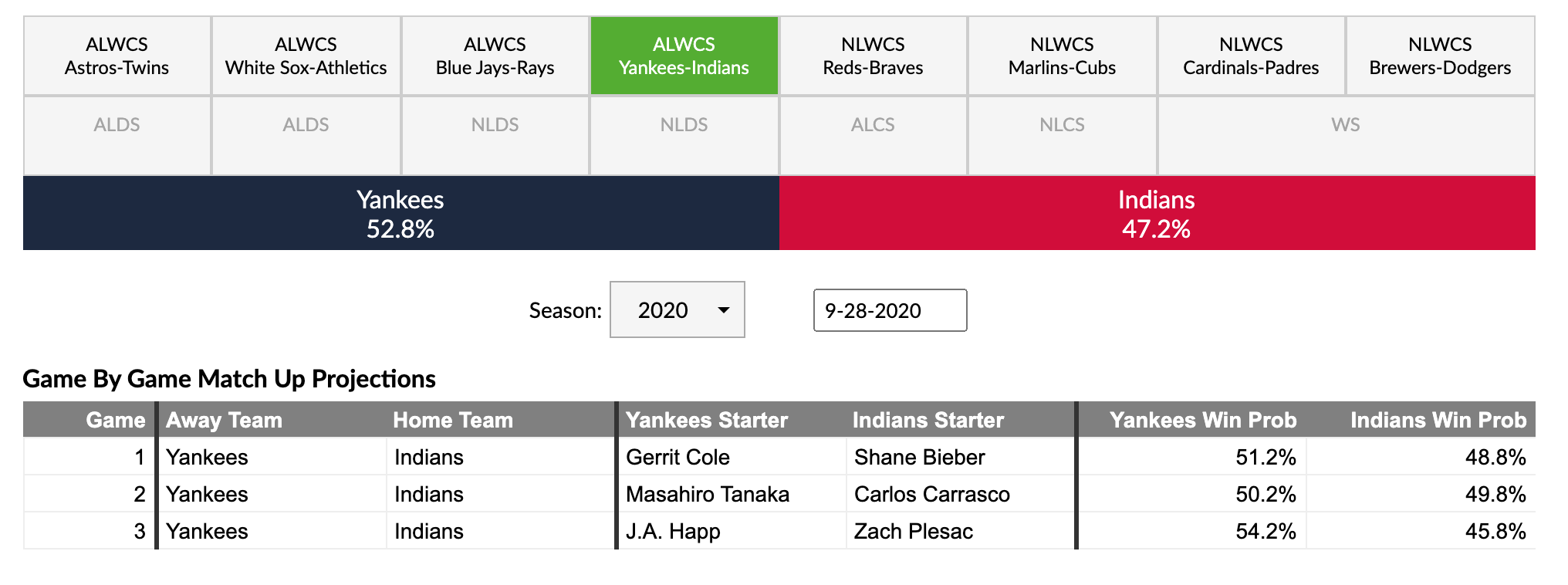As the final day of the season dawned, there were no fewer than six possible matchups for this series, with the Twins, White Sox, and Indians all having paths to second place in the AL Central and the number four seed, and likewise for the Yankees and Blue Jays in the AL East and the number five seed. The Yankees fell to the Marlins, 5-0, their sixth loss in the past eight games, but because the Blue Jays blew a 4-1 lead and lost to the Orioles, New York finished 33-27, barely holding onto second. Meanwhile the Indians dug their way out of a 6-2 hole against the Pirates, and only when the White Sox’s comeback from a 10-1 deficit stalled at 10-8, with the tying run at the plate in the bottom of the ninth on a questionable called strike was this matchup set.
The Indians finished with the better record, going 35-25, but a slightly worse run differential (+39 versus +45), but how the two teams got there is very different. The Yankees led the AL in scoring (5.25 runs per game) and wRC+ (116) while ranking sixth in run prevention (4.50 runs per game). The Indians, on the other hand, tied for second-to-last in the AL in scoring (4.13 runs per game) and were second-to-last in wRC+ (86), but they were the stingiest team in the AL, allowing just 3.48 runs per game. As this series will be played entirely at Progressive Field, the Yankees’ offensive advantage may not be all it’s cracked up to be.
Worth noting: Indians manager Terry Francona has been sidelined by gastrointestinal and blood clot issues for most of the season, managing just 14 games, during which his team went 8-6. First base coach Sandy Alomar Jr. has been serving as acting manager since mid-August and will likely remain in that capacity through the postseason, though Francona has entered the bubble to keep that option in play. The team has gone 28-18 on Alomar’s watch.
Rotations
Indians and Yankees AL Wild Card Series Starting Pitchers
| Name |
IP |
K% |
BB% |
K-BB% |
HR/9 |
GB% |
EV |
Barrel% |
ERA |
FIP |
WAR |
| Shane Bieber |
77.1 |
41.1% |
7.1% |
34.0% |
0.81 |
48.4% |
89.3 |
7.2% |
1.63 |
2.06 |
3.2 |
| Carlos Carrasco |
68.0 |
29.3% |
9.6% |
19.6% |
1.06 |
44.3% |
88.0 |
8.3% |
2.91 |
3.59 |
1.5 |
| Zach Plesac |
55.1 |
27.7% |
2.9% |
24.8% |
1.30 |
39.3% |
87.8 |
9.9% |
2.28 |
3.39 |
1.5 |
| Gerrit Cole |
73.0 |
32.6% |
5.9% |
26.7% |
1.73 |
37.4% |
90.9 |
9.1% |
2.84 |
3.89 |
1.5 |
| Masahiro Tanaka |
48.0 |
22.3% |
4.1% |
18.3% |
1.69 |
43.3% |
88.5 |
9.1% |
3.56 |
4.42 |
0.8 |
| J.A. Happ |
49.1 |
21.4% |
7.7% |
13.8% |
1.46 |
44.4% |
88.1 |
5.1% |
3.47 |
4.57 |
0.6 |
| Deivi García |
34.1 |
22.6% |
4.1% |
18.5% |
1.57 |
33.3% |
89.4 |
9.4% |
4.98 |
4.15 |
0.8 |
Read the rest of this entry »
 Dan Szymborski
Dan Szymborski


